Cassis 作者: 来源: 发布时间:2021-09-26
I.Population and Area
Region: Provence-Alpes-Côte d'Azur
Department: Bouches-du-Rhône
Code Insee : 13022
Code postal : 13260
Total Area: 26.87 km²
Population in 2017: 7149
Population Density: 270 /km²
Location: The altitude of the city hall of Cassis is approximately 23 meters. Its surface area is 26.87 km². The latitude and longitude of Villages are 43.217 degrees North and 5.539 degrees East. The towns and villages close to Cassis are: Carnoux-en-Provence (13470) at 5.10 km, La Ciotat (13600) at 6.87 km, La Penne-sur-Huveaune (13821) at 6.99 km, Ceyreste (13600) at 7.51 km , Roquefort-la-Bédoule (13830) at 7.95 km.
Histogram of demographic change
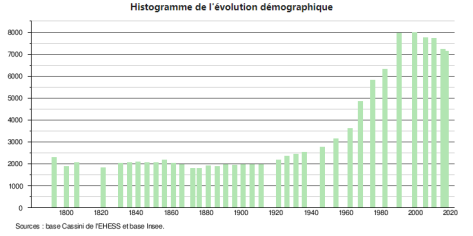
Sources : http://www.cartesfrance.fr/carte-france-ville/13022_Cassis.html
II.Natural Geography
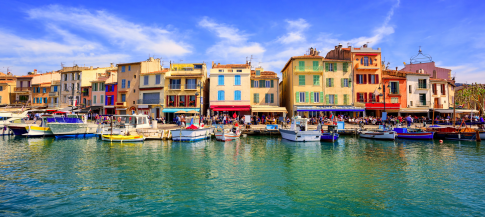
Geographical environment: Cassis is situated on the Mediterranean coast, about 20 kilometres (12.4 miles) east of Marseille. Cap Canaille 394 metres (1,293 feet), between Cassis and La Ciotat ("the civitas") is one of the highest maritime bluffs in Europe, a sailor's landmark for millennia. It is east of Marseille and in the department of Bouches-du-Rhône. One of its main beach, called "Bestouan" is made cooler by a karstic source. The caliber of its entire landscape is exceptional: Cassis is built like an amphitheatre by the sea between Cap Canaille and the rocky inlets of the Calanques. “A mineral gem in a green setting mounted on the blue water of the Mediterranean”. The ochre colour of the impressive cliffs of Cap Canaille, the highest in France (363 metres at Cap Canaille, 399 metres at the Grande Tête), contrast with the white of the mountains of the Calanques. These two listed natural sites count amongst the most beautiful on the Mediterranean Sea.
Climat: Located in the South of France, this municipality has a Mediterranean climate. The town is protected from the wind by the belt made up of the surrounding heights. The frosts are exceptional and it benefits from an exceptional duration of sunshine, with more than 2,800 hours of sunshine per year, in particular thanks to the mistral, which blows on average 93 days per year. On average, there is 525 mm of precipitation per year. They are the lowest in France and spread over 81 rainy days , mainly in autumn-winter. The average temperature is 23 °C. The rains fall mainly in winter but also in autumn and spring. The summer is dry with very little to no rain.
Transport:
(1) Traffic in the city: The Lignes Cartreize RDT 13 bus network (Régie Départementale des Transports des Bouches-du-Rhône) connects major cities and towns in the Bouches-du-Rhône département. La Marcouline Line M01 connects the Gare de Cassis SNCF with the center of Cassis at the Casino Barrière stop. La Marcouline Lines M6 and M8 connect Marseille with Cassis, stopping at the Gare de Cassis SNCF. You'll find route, schedule and fare information on lepilote.com.
(2) Trains: The fastest and most comfortable way to reach Cassis is by TER train from Marseille (35 to 45 minutes) or Toulon. The difficult part comes when you arrive in Cassis: The Gare de Cassis SNCF (train station) is 3 km (2 miles) north of the town center, and the only public bus is not coordinated with the arrival and departure of trains. You may find a taxi waiting at the Gare de Cassis, or you may be able to call an Uber car. If not, you may have to wait up to 45 minutes for La Marcouline Ligne M01, the shuttle bus to the Casino stop in the town center. Buy your ticket on board the bus. It's a 36-minute walk downhill along the D1 highway to the town center.
(3) Airport: The nearest major airport is Aéroport Marseille-Provence (MRS).
Sources : https://francetravelplanner.com/go/provence/cassis/transport.html
III.Economy
Today, the locals’ main economy is tourism and wine. Several very-small vineyards in the surrounding hills make wonderful white wine, much of which is available in the local restaurants. Don’t go looking for “crème de cassis” (which is the French liqueur—cassis is also French for blackcurrant). Cassis has some wonderful independent shops with high-end fashion or good quality-tourist items, like lavender-based products or Provençal fabric.
Income: According to Insee, in 2014, the inhabitants of Cassis earn on average € 3 015 net per month, or € 36 179 net per year, much higher than average income in France.
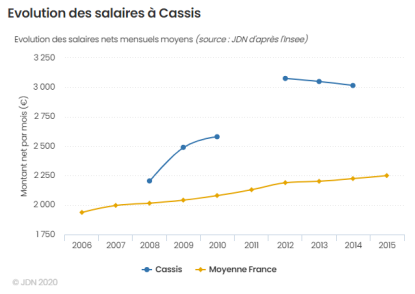
Evolution of average monthly net wages
Sources : http://www.journaldunet.com/business/salaire/cassis/ville-13022
https://theculturetrip.com/europe/france/articles/discover-this-gem-of-a-fishing-village-in-provence/
IV.Industrial Characterisitics
In the eighteenth century, Cassis started to develop outside the ramparts of the fortified city and around the port. After the Bourbon Restoration, new industries developed here, including the drying of cod, the manufacture of olive oil and clothing, coral work, wine-making and the exploitation of local stone (cement, limestone). Stone of Cassis, which was quarried here since antiquity made the town famous. It has been used for the quays of the large Mediterranean ports (Alexandria, Algiers, Piraeus, Marseille, and Port Said). In the twentieth century, the workforce turned to tourism and wine making.
Tourist: Cassis is a popular tourist destination,famous for its cliffs (falaises) and the sheltered inlets called calanques.
Viticole: Cassis is also one of France's outstanding wine-growing areas. One of the first three French wine regions to be classed as an AOC by decree on May 15, 1936, twelve wine estates produce 1,000,000 bottles per year from the 200 hectares of precious vineyards that tumble down the terraced slopes of the hills. All three colours are offered but the majority of the production is white wines. The wines of Cassis is one of the oldest places of viticulture in France.
Reconstruction of car: Cassis stands out in particular by a company called "Club 2Cv Méhari" specializing in the restoration - reconstruction of Citroën 2CV and Méhari automobiles, models of which PSA ceased production since 1990 and 1987 respectively.
Sources:https://www.ot-cassis.com/en/services/mehari-club.html
V.Attractions
1. The Calanques
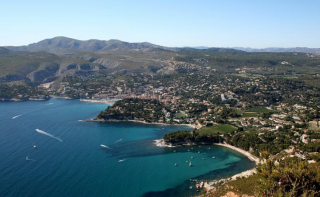
One of the main attractions in the region is the Calanques, a beautiful series of water inlets along the very-high coastline. The Massif des Calanques is a wild and rugged terrain stretching from the ninth arrondissement of Marseille to the east towards Cassis, spanning 20 km in length and 4 km in width along the coast. Its highest peak is Mont Puget at 565m. The area has been protected by a national park since 2012. They now form part of the national park and many people reach them either from the port in Marseille or in Cassis (in summer, Cassis is a great departure point for boat rides in and out of the Calanques). Those with a car, drive up to the cliff overlooking Cassis—the views are not to be missed and a great spot for a panoramic view across the Mediterranean.
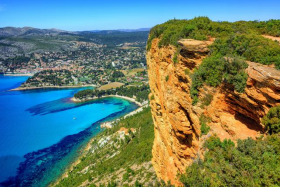
Calanques National Park (French: Parc national des Calanques) is a French national park located in Bouches-du-Rhône, in Southern France. It was established in 2012 and extends over 520 km2 (201 sq mi), of which 85 km2 (33 sq mi) is land, while the remaining is marine area.It includes parts of the Massif des Calanques stretching between Marseille, Cassis and La Ciotat. Several of the park's best known features include the Calanque de Sormiou, Calanque de Morgiou, Calanque de Port-Miou, Calanque de Sugiton, as well as the Cosquer Cave.
Cap Canaille is a headland situated in the Bouches-du-Rhône département, in southern France, on the Mediterranean Sea coast between the towns Cassis and La Ciotat and about 27 km (16 mi) from the centre of Marseille. At 394 m (1,293 ft), it is the highest sea cliff of France. The rock face of Cap Canaille is called Falaises de Soubeyrannes. The rock consists of layers of ochre-coloured sandstone, conglomerate and limestone from the Turonian age on top of grey marl from the Cenomanian until the Turonian age. The Corniche des Crêtes road runs over the top of the cliff.
Source: https://theculturetrip.com/europe/france/articles/discover-this-gem-of-a-fishing-village-in-provence/
2.The castle Cassis
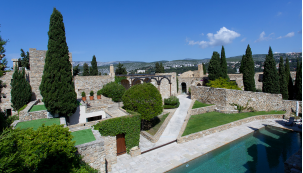
Located on the top of a hill overlooking the sea, this stately 13th-century castle is a 7-minute walk from the beach in Praj de la Grand Mer. The castle Cassis is a testament to centuries of history. The owners undertook six years of monumental renovation to erase the wear and tear of time and to restore the Château to its natural splendor, creating a warm and peaceful setting.
Both the interior and exterior design of the castle are respectful of the building's origins, and testify to a rich history that began in the V Century, during Roman times, where an early simple stone and wood watch tower was erected over the ancient city of "Carsicis Portus". During the VIII century, the first fortified walls rise around the tower, the remains of which are today's "Saracen" tower, an excellent testament to the site's rich architectural history.
In the XV Century there are as many as 50 homes and 250 inhabitants inside the castle walls. In 1426 and again in 1473, the fort passes by succession to Louis II.
The property is officially ceded by land administrators to a tobacco grower from Saint-Cyr in the Var region, who purchases the castle in 1896. Since this initial purchase, the Château de Cassis has remained a private property.
Address: Chemin des Lombards, 13260 Cassis FRANCE
Source: http://www.chateaudecassis.com/en/the-castle.html
3.The Church of Saint Michel
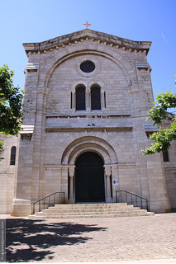
The Church of Saint Michel is believed to have been built in the Middle Ages and belonged to the Baux family in 1381. Rectilinear ramparts with square towers mark out the area of a 4850m2 fortified city.
It dominates the town, set on top of a cliff of blue marl dating from the Cretaceous, a quite interesting geological site. It is today privately owned and run as a luxury bed and breakfast.
The 19th century Church of Saint Michael (French: Eglise Saint Michel) is located uphill in a quiet neighborhood. The bell tower is visible from the port below. The current 19th century church, built on the site of the former chapel of the Black Penitent’s, replaced several previous churches including a 16th century castle church also dedicated to Saint Michael. The church is small and rather simple. The interior features several statues, including one of Saint Michael slaying the dragon, a couple of paintings such as the Madonna and Child hanging above a marble side altar,beautiful stained glass windows, the topmost of which features the crest of Cassis (two fish flanking a bishop’s crozier), a semi-circular fresco behind the main altar, The main organ, above the entrance, is a dazzling azure blue and reportedly was rebuilt for the church by a local vintner.
Location: Place Saint Michel
Source: http://mikestravelguide.com/things-to-do-in-cassis-visit-the-church-of-saint-michel/
4.The Chapel of Notre Dame de Bon Voyage
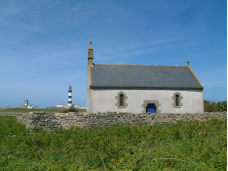
Located in the village of Locqueltas, just before the tip of Pern ... We pass in front of a stone trough which, according to legend, is the boat on which Saint-Gildas crossed the Channel.
The chapel was built in the village of Locqueltas at the end of the 19th century on the site of an old building from which some elements have been reused.
A pardon was celebrated there every year on the first weekend of September.
Location: Rue de L'Eglise, 13600 La Ciotat France
Sourec: https://ot-ouessant.fr/les-sites-religieux/339-la-chapelle-notre-dame-de-bon-voyage.html
5.The Mediterranean Museum of Art and Popular Traditions
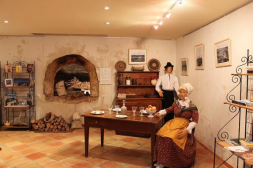
The Mediterranean Museum of Art and Popular Traditions in Cassis, laid out in a former rectory from the early 18th century, houses a beautiful collection of works by 19th and 20th century Provençal painters: Ponson, Crémieux, Guindon, Seyssaud, etc.
Located in Rue Thérèse Rastit, in the heart of the historical fishermen’s quarter, it dates from the second half of the 17th century. With its remarkable dimensions and excellent state of preservation, it bears witness to the activities of bygone days.
Just two steps away from the harbour, in the heart of the town, the museum is housed in a former presbytery dating back to the beginning of the 17th century. The building may be austere, but the interior–all charm and balance–is sure to seduce you as soon as you enter. There is a succession of permanent and temporary exhibitions, and Christmas is regularly celebrated there in a very special way.
Its collections of paintings (the oldest one dates from 1601), its Roman remains and amphorae propose a diversity that’s sure to charm the visitors.
In the museum, you can visit THE COMMUNAL OVEN, also called the Four Banal, which is open to the public from 9am to 12.30 and from 1.30 to 5pm, every Monday, Tuesday, Thursday and Friday, and on Wednesdays from 9am to 12.30pm (except on public holidays).
Source: https://www.ot-cassis.com/en/culture.html
6.The port of Cassis
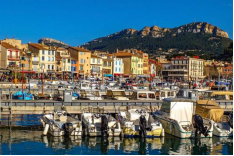
Cassis inevitably evokes a colourful fishing port. In the days when Cassis was still a busy fishing port, fishermen would paint their boat the same color as their house. Nowadays it remains a bustling and colorful harbor surrounded by restaurants.
Location: Quai des Baux, 13260 Cassis,France
Sources : https://www.marvellous-provence.com/other-places/towns/cassis/town-guide
VI.History
The site where Cassis now sits was first occupied between 500 and 600 BC by the Ligures, who constructed a fortified habitation at the top of the Baou Redon. These people lived by fishing, hunting, and by farming.The current site of Cassis could have been inhabited by the Greeks, though no proof has yet been found.
During the Roman times, Cassis was part of the maritime route made by the Emperor Antoninus Pius. It was a small village, established mainly around the Arena and Corton beaches. The principal livelihood was fishing and maritime trade with North Africa and the Middle East. Several archaeological discoveries attest to this.
From the 5th to the 10th century, invasions by foreign tribes led the population to seek refuge in the castrum, a fortified city that, in 1223, became the property of the Seigneurie des Les Baux-de-Provence.
In the fifteenth century, Cassis was ceded to the Counts of Provence, then René of Anjou gave the town to the Bishops of Marseille, who ruled the town until the Revolution of 1789.
VII.Other information
Nestling in a natural casket where pine forests rub shoulders with ochre and white rocks, the vineyards on the plains and terraces that stretch down to the Mediterranean sea, Cassis is protected by the two monuments of nature that are Cap Canaille(tallest coastal cliff in Europe) glowing red when the Mistral blows, and the white limestone Calanques.
In 2018, the village was awarded the fourth flower of the "Villes et Villages Fleuris" label.
The wines of Cassis is one of the oldest places of viticulture in France. The vines already existed on the site of Marseille and its surroundings even before the landing (around 600 BC) of the Greek sailors (the Phocaeans).
Sources : https://www.ot-cassis.com/en/cassis-village.html
VIII.Contact information
Address of Cassis town hall:
Mairie de Cassis
Place Baragnon
13260 Cassis
Phone number: 04 42 01 66 66
Fax: 04 42 01 34 39
E-mail: accueil@cassis.fr
Website: http://www.cassis.fr
Mayor : Danielle Vivanti-Milon (Mandat : 2014-2020)
Sources : http://www.cartesfrance.fr/carte-france-ville/13022_Cassis.html#mairie
